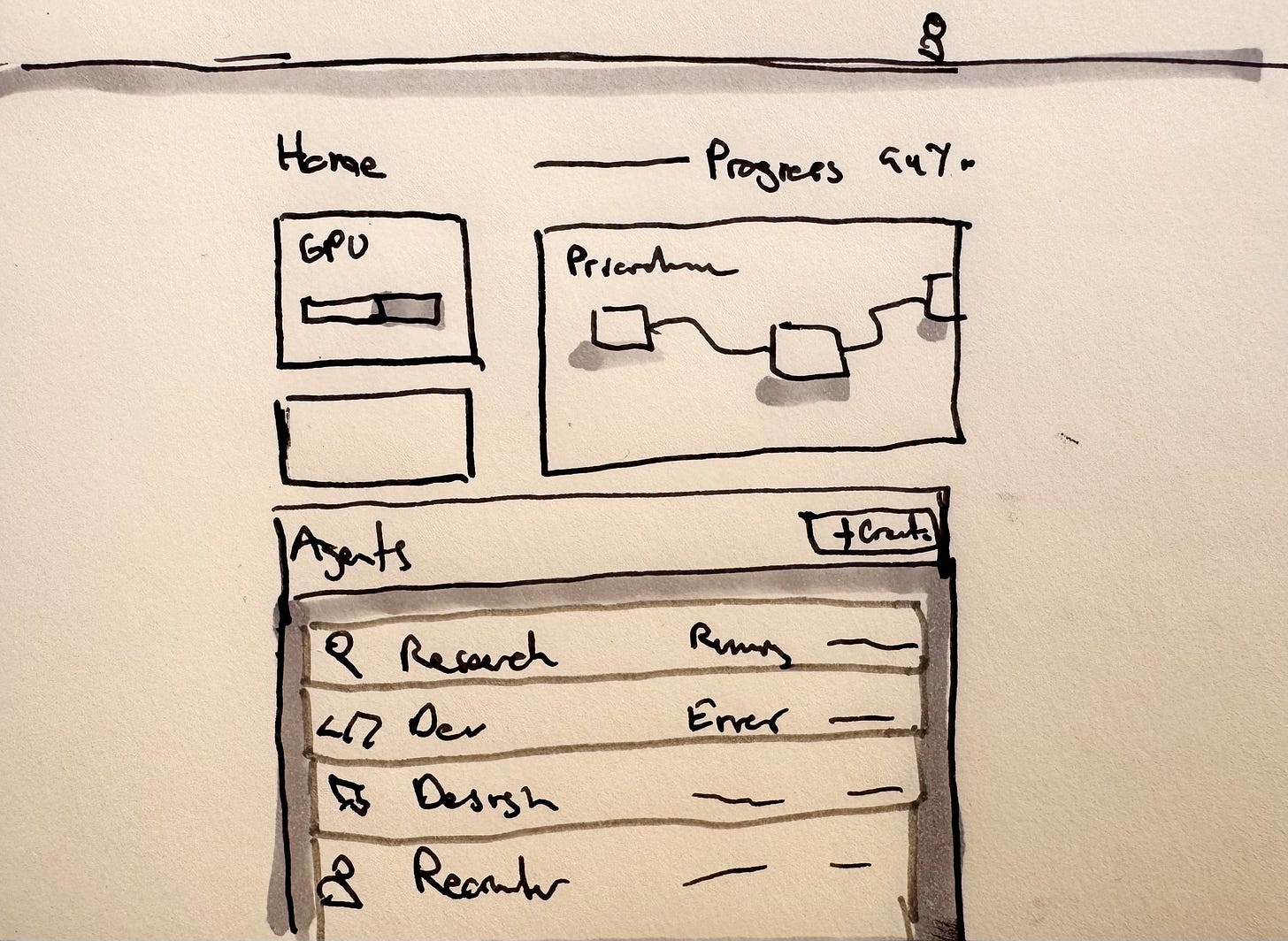Real-Time Strategy games and AI interfaces
Issue 247: How early computer gamers have been trained for Agent orchestration
Last week, I posted online that millennials were built for Agent orchestration, comparing it to playing a Real-Time Strategy game. Claire Vo, CPO of LaunchDarkly and I joke a lot that we were built for management because of the hours of StarCraft II played growing up. Despite joking, it's valid and the skills you learn from playing such games are now very transferrable as we seemingly are controlling computers for work at a more advanced level.
Resource management (gathering wood, gold, food, minerals, etc.)
Base building and construction
Unit production and recruitment
Combat and military tactics
Territory control and expansion
Technology research and upgrades
Economic development and trade
Ultimately, RTS games are about multi-tasking, prioritizing, and executing to achieve victory.
Resource management
Compute isn’t free (yet). In the world of agent orchestration, compute might feel “invisible” but just like in any RTS game, resources are finite, and your success depends on how you manage them. Some believe we’re heading toward a world where compute is ambient and effectively free. Maybe someday. But today, spinning up a swarm of agents, chaining model calls, or running fine-tuned LLMs still comes at a real cost:
GPU time isn’t infinite.
Token limits constrain context windows.
Inference speed introduces trade-offs between performance and quality.
API usage impacts both budget and throughput.
In Command & Conquer, players had to harvest Tiberium to fund their armies and base upgrades. You couldn’t just build infinite tanks—you needed to gather, refine, and spend strategically. Agent orchestration is no different: your compute, bandwidth, and time are the modern equivalents of wood, gold, and stone.
This means:
You decide which agents to run and when.
You budget for high-cost operations (e.g. fine-tuned summarization vs. quick heuristics).
You optimize for parallelism, batching, and latency.
You monitor spend and drift the same way you’d watch your RTS economy.
The skill isn’t just about knowing what agents can do—it’s knowing when they’re worth the compute.
Agent orchestration is shaping up to be a game of intelligent resource allocation. Efficiency matters. Waste compounds. Just like in RTS games, the best players aren’t the ones who build the most—they’re the ones who use the least to do the most.
Multitasking is a core skill of agent orchestration
One of the most transformative advances in AI agents right now is their ability to operate asynchronously and ambiently. This is a huge leap from earlier AI tools, where interaction was mostly transactional: you’d ask a question, get an answer, and repeat.
With models like Claude 4 and GPT-4o, multi-turn and persistent memory are now part of the interaction model. You can delegate a multi-step task—like “research the top competitors and summarize their positioning”—and return later to a synthesized result. It feels less like chatting with a bot and more like commanding an intelligent co-worker.
In RTS terms, this is classic split attention: you send a squad to harass the enemy’s expansion, then shift your focus to base construction, tech upgrades, or managing a separate battlefront. The agent executes its orders in parallel while you manage the broader strategy.
This is why multitasking is such an essential skill in this new interface paradigm. Just like in RTS games:
You delegate tasks with clear intent.
You cycle between fronts (or browser tabs, Slack threads, and dashboards).
You trust agents to execute while you shift your attention.
You return to results, synthesize progress, and re-issue commands.
What’s emerging is a kind of asynchronous command loop, where the orchestrator (you) doesn’t need to micromanage every step. You operate at a higher altitude, focusing on coordination rather than execution.
This ambient agent loop enables a workflow where parallel tasks can be in-flight without blocking your momentum. It’s not just “chatting with AI”—it’s commanding a distributed system of intelligent agents, RTS-style.
Instructing units as prompting
In RTS games, commanding your units is both an art and a science. You don’t just mindlessly click—each instruction considers the unit’s role, strengths, and the context of the battlefield. You might send siege units to break defenses, scouts to reveal fog-of-war, or medics to support infantry mid-fight. Good players know when to issue commands, how much detail to provide, and which units to trust with high-stakes missions.
That’s exactly what prompting is like in the age of AI agents. Prompting isn’t just about typing a clever sentence into a text box. It’s about understanding your tools’ capabilities—and limitations—and issuing the right level of instruction to achieve the goal. This includes things like:
Precision: Are you giving the model enough context to succeed?
Timing: Are you waiting for one task to finish before chaining the next?
Delegation: Are you offloading the right type of task to the right model?
Fallback strategy: What happens when the agent misfires—do you reroute, retry, or reset?
Much like in Age of Empires or StarCraft, where different units have different purposes (and sometimes overlapping capabilities), AI orchestration requires model selection. Do you use a long-context model for a research task? A lightweight, fast-response model for summarization? A specialized agent fine-tuned on legal language for contract review? Prompting is commanding units. Model selection is unit competition, and Orchestration is your battle strategy.
You’re not just “using AI”—you’re commanding an increasingly capable set of autonomous and sentient tools. Like any great RTS player, your job is to read the map, know your units, and issue clear, timely instructions. Victory isn’t about brute force—it’s about command fidelity.
What about an RTS interface?
It might sound strange, but the interfaces of work are starting to resemble games:
Mission control dashboards (Notion AI, Anthropic Console)
Spatial computing workspaces (Apple Vision Pro, Gather, Spatial)
Swarming assistants (AutoGen, crewAI, DevOps agents)
When I was at Replit, engineers would gather in virtual HQs to debug together—literally inhabiting a shared digital space. The metaphor is no longer metaphorical. Why shouldn’t we be commanding agents with a spatial, visual UI?
The RTS interface for work
I’m not suggesting our work interfaces will look precisely like a RTS game. However, let’s speculate what might an RTS-inspired orchestration tool include. The home experience may look like a real-time Mission Control: an overview of all running agents, states, and goals.
The dashboard level gives you an abstracted view and summary of what’s needed at that level. Amelia Wattenberger gave a great example in her talk, Climbing the Ladder of Abstraction. She uses a book as an example and conveys different types of summaries necessary depending on the view. If it’s a chapter, the summary looks different than at the paragraph level.
An RTS-inspired UI might have the same experience. It has a figurative (or literal) map of an abstracted project overview that allows you to Zoom in at the specific task. For example, a user may see a coding agent with a progress indicator at the dashboard level but can quickly drill down to watch the agent work.
As a result, we’ll see interfaces with more embeddable views than having to switch between different apps silo’ed in their own walled gardens.
The RTS mindset for a new era of work
Whether you take the interface literally or not, real-time strategy games offer a powerful mental model for agent orchestration. The parallels are clear: managing distributed systems, juggling competing priorities, issuing precise commands, and making the most of finite resources.
In today’s workflows, much of the labor is shifting from hands-on execution to asynchronous oversight. Agents operate like background workers. They are parallel processes you check in on, redirect, or scale up—not unlike sending units across a map and pivoting your focus elsewhere. The future of work won’t be a 1:1 remake of StarCraft, but it will reward the same instincts: Systemic thinking, context switching, resource awareness, and strategic delegation.
If you grew up commanding virtual armies, you may be more prepared for this next wave than you think.
Hyperlinks + notes
A collection of references for this post, updates, and weekly reads.
NYCxDESIGN
I had the pleasure of speaking at NYCxDESIGN this past week about The Future of Software Design. I’m grateful to Will Hall for the invite and make a quick trip to one of my favorite cities in the world.
Angel Investing for Designers
I'm excited to host with Bain Capital Ventures an event in San Francisco. If you've been angel investing-curious, we'd love to see you. Unfortunately we will not be steaming this or have a remote component as it requires more logistics to do this. Event details
Links
Why Agents Break PLG (And How to Rebuild It)|The Notorious PLG
The State of AI Design | Designer Fund and Foundation Capital
The last generation to speak "computer" |






Loved the parallels! Who knew that playing Age of Empires II as a kid would prepare me for my job 20+ years later
Such a great insight. It'll be interesting to see how interfaces change over time.